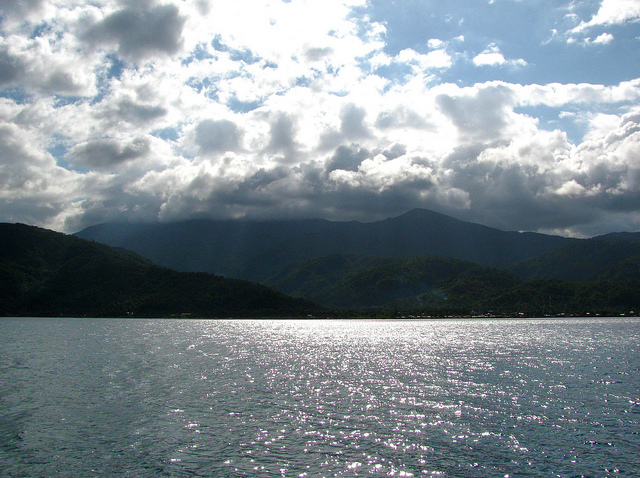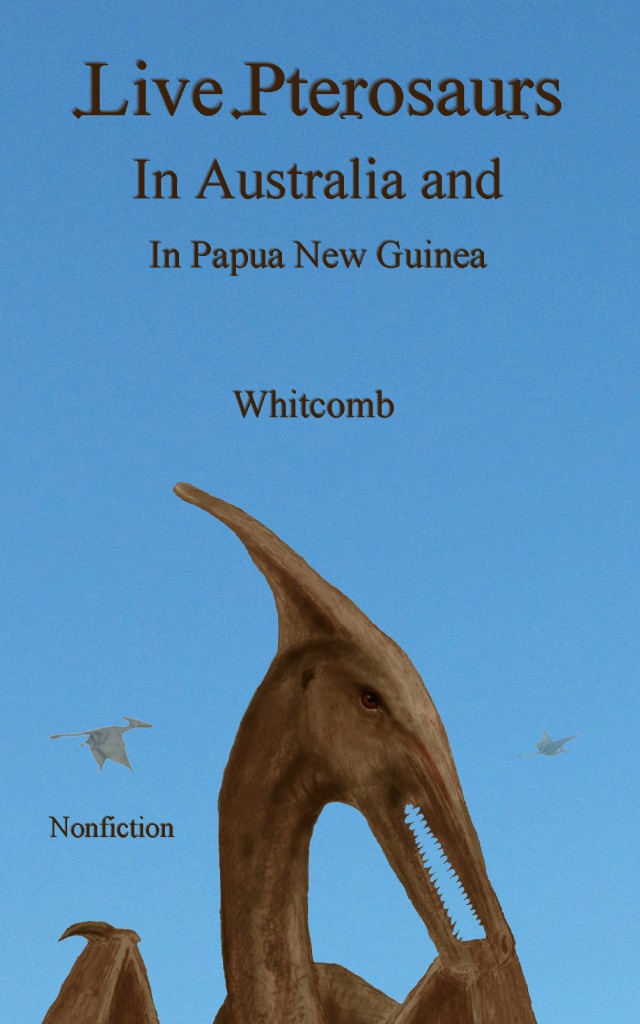I admit somebody, somewhere in a boat on a sea, may be shocked at the sight of a Manta ray fish jumping up out of the water, perhaps as high as ten feet above the surface. But I object to the conjecture of Mr. Drinnon, that such appearances have caused “many” of the reported sightings of living pterosaurs.
He says nothing about how he has selected the sightings; he mentions nothing that suggests he ever had any specific idea about any selection process. To gain any significant confidence in his jumping-fish conjecture, one must dive into ones imagination to search down into the depths of murky possibilities, while ignoring the clear images that live up above, in the real world; I suggest examining all the relevant details in actual eyewitness reports.
In reading two of Mr. Drinnon’s blog posts (both mentioning the fish-misidentification possibility for living pterosaur sightings), I have seen nothing that gives any hint that he has read any edition of any of my three nonfiction books on sightings of modern pterosaurs. I also doubt that he has read my scientific paper published on that subject. It seems that he has read at least one of my blog posts, probably at least two; but I have written over a thousand posts and web pages over the past nine years. I suggest that skeptics in general should read more than one or two online posts before writing much criticism of the concept of modern pterosaurs.
In a reply-comment in a recent post by Mr. Drinnon, he said, “The wingspan of a ptersaur [sic] like Pteranodon (the one that is theoretically most like the reports) . . .” But for years my writings have made it clear that the great majority of sightings of apparent pterosaurs suggest the Rhamphorhynchoid type, NOT the Pterodactyloid type. The Pteranodon is the short-tailed variety, not the long-tailed. But he seems so focused on the standard-model ideas that he refuses to consider the possibility that an extant pterosaur could be a Rhamphorhynchoid.
I don’t object to the use of real scientific criticism; but I do object to the use of a straw man argument. Since Mr. Drinnon has mentioned a Pterodactyloid pterosaur, as if it were typical in modern sightings, consider some examples that he does not mention:
- Central New Britain sightings by three or four eyewitnesses, over a period of many months—those were flights high above a jungle canyon or valley, far inland from the sea, many miles away from the sea. No Manta ray was involved. (Read the nonfiction book Searching for Ropens, second edition).
- Desert in Southern California—that flight was very high above the desert, many miles away from the ocean. No jumping fish was involved. (Read the latest edition of the nonfiction book Live Pterosaurs in America)
But why examine those few sightings of short-tailed pterosaurs? Let’s look deeper into remarks by Mr. Drinnon in relation to the common sightings, those that were obviously Rhamphorhynchoids or at least could have been long-tailed pterosaurs.
Hair Before on Pterosaur
Consider fossils of pterosaurs. At least some species show evidence of hair, at least on some parts of their bodies. Some fossils leave little room for doubt; Sordes pilosus is an example. But Mr. Drinnon takes this concept too far, trying to pin hair onto all parts of the bodies of all pterosaurs, including any that might still be living on this planet.
He mentions that pterosaurs (meaning those that left fossils that have been discovered and examined by paleontologists) had “fine hair or fur.” He uses that idea as if it repudiates descriptions in reports that I have received. Since he seems to have neglected reading my books, I quote from the third edition of Live Pterosaurs in America:
“They were huge! [Their feet] wrapped around a 2”x6” plank; I just couldn’t believe it! [Their] heads I would have to say it was maybe 4 ft long with the beak. . . . a brown body color that looked like hair . . .” (page 62)
“the end of the tail had a ‘tuft of hair‘.” (page 126)
Some eyewitnesses do indeed report the presence or possibility of hair.
Now for quoting from my ebook Live Pterosaurs in Australia and in Papua New Guinea:
“The body also still appeared leathery, though textured as though possibly covered with fine hair or small scales . . .” [Perth sighting of 1997]
Also from my nonfiction Live Pterosaurs in Australia and in Papua New Guinea is a report that seems, on the surface, to confirm Mr. Drinnon’s objection to the lack of hair in eyewitness’s descriptions. I admit that there was a reference to lack of hair in this particular sighting a few years ago. It was off the coast of Umboi Island where several native eyewitnesses saw a ropen in the sea over a reef:
“. . . It was floating 10 meters away from the boat and its color [probably referring only to the tail] was brownish-dark without any form of hair.”
But that description needs to be taken in context. I don’t recall asking the eyewitness about hair (or lack thereof) in our email communications; I rarely ask any question about hair in brief interviews. Why did he bring up the subject of hair? I suggest he mentioned the lack of any appearance of hair (probably referring to part of the tail) because of the tradition on Umboi Island: The ropen is said to have hair. This presence of hair on the ropen is not just something I learned from watching videotaped interviews with natives of Umboi: I encountered this “hair” idea during my own expedition on that island in 2004. I heard it during my face-to-face interviewing on Umboi Island.
Hair Objection – a Simple Refutation
I don’t recall reading anything, by a paleontologist, suggesting that no species of pterosaur was hairless. Even if all those known from fossils did have hair, why should all modern pterosaurs have hair? Why should Mr. Drinnon insist on that point? He gives no reason for that position.
Another Objection to Lack of Hair
How often do we see no hair on the arms of humans on a sunny beach! From a distance of more than fifteen yards, how could we see any hair on human arms, except maybe a man having light skin but dark arm hair? For most humans, that’s too far away to see that human hair. But how many sightings of apparent pterosaurs are from a distance of more than fifteen yards!
I suggest that skeptics look deeper into this phenomenon of cryptozoology before throwing out simplistic criticisms.

In the above reproduction of the sketch of two pterosaurs in Cuba, the tail vane shows nothing suggesting hair. But Mr. Kuhn did mention to me that possibility of hair at the tail end, and he believes that his original sketch shows that hairy appearance.
.
Hornbill Birds and a Live Pterosaur
The skeptic mentions both the 1944 sighting by Duane Hodgkinson and the 1971 sighting by Brian Hennessy. . . . consider the . . . descriptions of the flying creature seen by Hodgkinson (DH) and Hennessy (BH) . . .
Those few sighting that were of creatures over the sea—some of them involved long periods of flight, far longer than the few seconds it takes for a Manta ray fish to jump out of the sea and fall back into the water.
How desperate is the critic of living pterosaur reports, the skeptic who suggests people are observing large fish that jump up above the surface of the sea!




